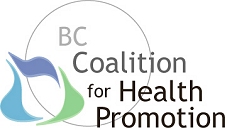
The Quw'utsun' Cultural and Conference Centre proved to be an excellent choice for our conference. Its buildings and rooms, constructed and decorated in the rich, natural forms of the Quw'utsun' culture, created a symbiosis between the surrounding river and forest, and in this way supported the holistic nature of health promotion. Approximately 135 persons attended the event and valued the opportunity for connecting with others in the field. Else Strand, conference co-ordinator, welcomed everyone and introduced Quw'utsun' tribe members, Ron George and Sarah Modeste, who together blessed the event with a First Nations traditional Quw'utsun' prayer and song. Ronnie Phipps then introduced the goals and aspirations of the BC Health Promotion Coalition (BCHPC), and discussed some of its achievements and challenges, including that of raising the profile of the volunteer sector, without whose work health promotion would be off the radar screen in Canada. She also described the purpose of the conference: to showcase both the health promoting contributions of local citizens and the health promoting opportunities in the Cowichan Valley, and to suggest ways in which we can improve our own health and quality of life. Keynote speaker Dr. Trevor Hancock began his Walking the Talk: Local Policy, Local Actions for Health presentation, making the point that whereas institutions operate as hierarchies and learn from studies, communities form networks and learn from stories. He identified four strategies for creating change listed in the Ottawa Charter for Health Promotion that are pertinent to community development: i) Build health public policy, ii) Create supportive environments, iii) Strengthen community action, and iv) Develop personal skills. New public policies should promote health and make quality of life in our communities a priority. The Community Charter implemented across BC this year is a conceivable means for shifting social norms. |
By-laws do/can/could restrict smoking in public spaces, eliminate use of pesticides, require recycling, control noise, encourage use of public transit, enable affordable housing, and encourage pedestrian only town centers. The second strategy of creating supportive environments addresses everything from households to schools, hospitals, and prisons, and the physical structure and layout of communities. The first priority should be people, not cars and enhance the lives of pedestrians and cyclists. Rain water could be used and reused and a "Living Machine" could serve the dual purpose of greening communities and treating their sewage. To strengthen community action and develop personal skills, municipalities might invest in the social capital of their populations, by providing no-cost leadership training and skills development for all sectors of society. Facilitating citizens to contribute to decisions concerning their own communities is itself an endeavour that promotes health. Schools, hospitals, prisons, businesses, service clubs, the men and women at the local coffee shop, all can contribute to promoting health. For example, Dr. Hancock asked: How healthy are our local institutions, such as hospitals? He pointed out numerous inconsistencies in hospital and educational systems and challenged us to imagine the enormous power a hospital would have if it were at the forefront of health promotion. Finally, in refocusing attention on the individual, Dr. Hancock encouraged us to think about what we might do to develop and strengthen our own skills for participating in community action and leadership. A major skill is basic literacy, yet the illiteracy rate in BC is 25%. Interpersonal and oral skills are other basic necessities for community participation. Dr. Hancock concluded his presentation by reiterating that most health promotion stories begin with citizens actively engaged and joining with others, as we did at this conference. He encouraged everyone to know their own story, and to keep learning and acquiring new skills. Both we and our communities will benefit. |
| Who We Are | What's New | Our Publications | Our Funding Framework | Other HP Resources | How to Reach Us |
|
Site design by Chrystal Ocean. Copyright © . Last modified |